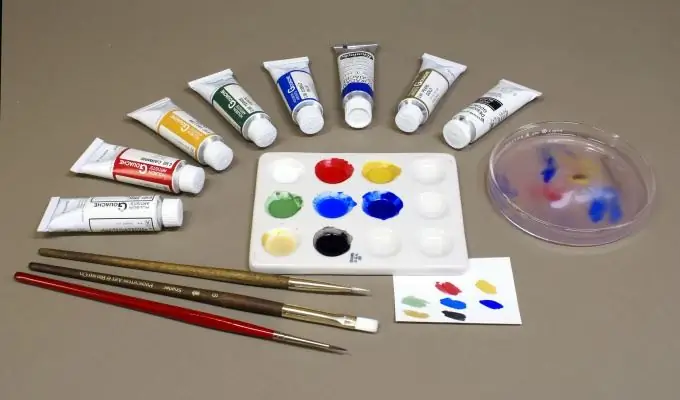Gouache is an ideal art material for aspiring painters. Painting is much easier for her than with watercolors or oils. It's easy to handle, but these paints have their own characteristics.

Instructions
Step 1
Gouache is an opaque and thick paint. She doesn't like water. Consider this when choosing brushes. A squirrel brush is ideal for watercolor, but it is undesirable to use it when painting with gouache. It is best to choose a brush that is not highly absorbent. Column and bristle brushes (natural or synthetic) work best for gouache. The cheapest option would be a natural bristle brush. In the set you need to have brushes of different shapes and sizes: thin and thick, flat and round. Remember that gouache is a fairly heavy paint, it lays down in thick layers, so the paper should be dense and not get too wet.
Step 2
First you need to learn how to mix colors. Unlike watercolor, which can be mixed directly on paper, gouache is heavier and thicker. To mix it you need a palette. As a palette, you can use a thick sheet of paper, cardboard, plastic or wooden board. Stir the colors thoroughly until a homogeneous mass is obtained. First, experiment with color, check what shades are obtained by mixing several primary colors. You can divide the sheet into several small squares, and paint over each of them with the new resulting shade.
Step 3
When starting to paint with gouache, remember its main property: it is an opaque paint. If you made a pencil sketch before writing with color, then it will not show through the layer of paint. The colors easily overlap each other, so the order in which the details are drawn becomes unimportant. You can start with the darkest objects, or you can start with the lightest ones. If some part of the painting is not entirely successful, wait until the layer is completely dry and modify it again. You don't need to get too carried away with overlapping layers, as a result you can get a "dirty color".
Step 4
Experiment with textures. On a clean sheet of paper, do a series of strokes, wetting the brush harder each time. Start with a completely dry brush and finish with a very wet one. You will find that the paint lays down differently every time. With a dry brush, it is ideal to draw small details in the final stage. You can also use a toothbrush to spray paint, a sponge, a tissue, or even your fingers.
Step 5
Watch the condition of the brush! If there are particles of old paint on it, it can spoil the mixed shade. There should always be enough clean water and a cloth to wipe the brush. If the brush is old and the pile is coming out of it, do not paint with it anymore, otherwise fine hairs will remain on the paper.






